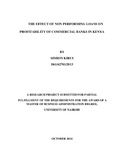| dc.description.abstract | Kenya commercial Banks have remained with persistent challenge of managing non performing
loans that are considered to have effects on its profitability. The government together with the
banking sector has established various ways of reducing non performing loans. Measures introduced
include licensing of Credit reference Bureaus. This study seeks to find out the effects of
nonperforming loans on profitability of commercial banks in Kenya. The study used commercial
banks registered and operational in Kenya as at CBK (2013). Profitability measured by return on
assets is used as dependent variable and non performing loans measured by non performing loans
ratio is used as independent variable. To improve the accuracy and reliability of the tests Capital
adequacy, Operational efficiency and Liquidity are used as control variables. The control variables
used are part of CAMEL factors that also affect profitability of commercial banks. At the
end of the study the effect of nonperforming loans measured by non performing loans over total
loans on profitability measured by return on assets (ROA) was determined. The effects of control
variables on the relationship between non performing loans and return on assets were also
determined in the study. The research covered all commercial banks in Kenya for the last ten
years that is 2004-2013. The study used secondary data to analyze and draw conclusions and
recommendations. Multi-linear regression model similar to one used by Kaaya and Pastory
(2013) to analyze the effect of credit risk on banks’ performance in Tanzania by controlling the
effect of deposits and bank size was used. The study indicates that there is negative effect of
nonperforming loans ratio on return on assets, confirming that non performing loans negatively
affects profitability of commercial banks in Kenya. The study is in agreement with Kaaya and
Pastory (2013) in the fact that other factors other than non performing loans affect profitability of
commercial Banks. Managers of Commercial banks in Kenya have to work hard to enhance
profitability of commercial banks and reduce occurrences of nonperforming loans. This includes
taking measures to mitigate against moral hazard and adverse selections in advancing loans,
example, use of credit reference bureaus. Central bank of Kenya should enhance supervision of
commercial banks and consider analysis of relationship between ratios of nonperforming loans
and profitability to enhance understandability and avoid concentrating on quantum figures alone.
Central bank and shareholders should also take action to caution against possible use of provisions
for losses on non performing loans for smoothing earnings by the managers. This paper
therefore provides an insight to commercial banks, central bank and other stake holders on the
effect of nonperforming loans on profitability of commercial banks in Kenya and provides a
basis for further research. | en_US |

